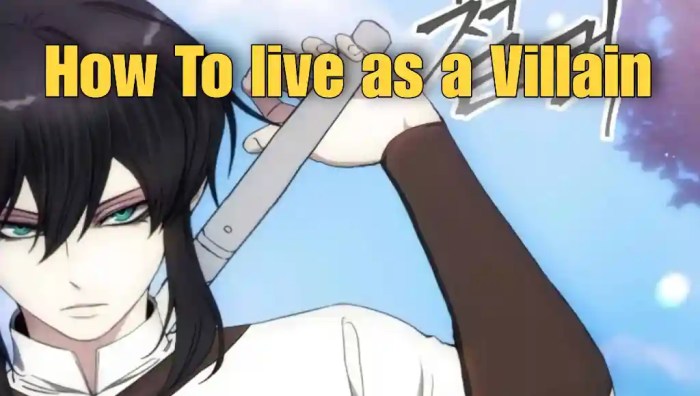
Step into the shadowy realm of villainy with “How to Live as a Villain Ch 94,” a captivating guide that unveils the intricate strategies, motivations, and world-building techniques that shape the enigmatic persona of a successful villain.
This comprehensive exploration delves into the villain’s mindset, empowering readers with insights into their schemes, ethical implications, and the intricate relationships they forge with allies, enemies, and victims.
Villainous Mindset and Strategies: How To Live As A Villain Ch 94
To succeed as a villain, one must possess a unique mindset and employ cunning strategies. The villainous mindset is characterized by a disregard for societal norms, a thirst for power, and a willingness to use any means necessary to achieve one’s goals.
Successful villains meticulously plan and execute their schemes, often using deception, manipulation, and intimidation to achieve their objectives. They are adept at anticipating the actions of their opponents and adapting their strategies accordingly. While the ethical implications of villainous actions are often overlooked, it is important to note that villains often justify their actions as necessary evils or as a means to a greater good.
Villainous Motivations
- Lust for power
- Desire for revenge
- Sadistic enjoyment
- Ideological extremism
Planning Villainous Schemes
Effective villainous schemes require careful planning and consideration of the following factors:
- Identification of targets
- Assessment of resources
- Development of contingencies
- Execution of the plan
Ethical Implications of Villainous Actions
The ethical implications of villainous actions are complex and often controversial. Some argue that villains are inherently evil and deserve punishment, while others believe that their actions may be justified in certain circumstances.
The ethical implications of villainous actions depend on a variety of factors, including the nature of the actions themselves, the intentions of the villain, and the consequences of their actions.
Character Development and Relationships
Creating a compelling villain requires crafting a complex and nuanced character with a backstory, motivations, and personality that resonate with readers or viewers. Understanding their inner workings and desires helps establish their credibility and relatability.
Relationships play a crucial role in shaping a villain’s character. Their interactions with allies, enemies, and victims provide insights into their values, priorities, and how their actions impact the world around them. Exploring these dynamics adds depth and complexity to the narrative.
Backstory and Motivations, How to live as a villain ch 94
- Develop a backstory that explains the villain’s origins, childhood experiences, and formative events that shaped their personality and worldview.
- Establish clear motivations that drive the villain’s actions. These could be personal grievances, ideological beliefs, or a thirst for power.
Personality Traits
- Create a unique personality for the villain, including their strengths, weaknesses, and quirks. Consider their intelligence, charisma, and emotional vulnerabilities.
- Avoid stereotypical villainous traits. Instead, strive for originality and depth, making the villain a memorable and engaging character.
Relationships with Allies
- Villains often have allies who support their goals. Explore the dynamics of these relationships, including loyalty, trust, and shared values.
- Consider how the villain interacts with their followers and subordinates, and how these relationships influence their decision-making.
Relationships with Enemies
- The villain’s enemies provide obstacles and challenges that test their abilities and motivations.
- Explore the personal and ideological conflicts between the villain and their adversaries, and how these relationships shape the narrative.
Impact on the World
- The villain’s actions have a ripple effect on the world around them.
- Consider the consequences of their schemes, the victims they create, and the impact on society as a whole.
Worldbuilding and Setting

Creating a unique and immersive world for the villain to inhabit is crucial for a compelling villainous tale. This world should serve as a backdrop that both supports and challenges the villain’s actions, providing a rich context for their motivations and choices.
The physical environment, social structure, and political landscape of the villain’s world should be carefully crafted to reflect their character and goals. For instance, a villain seeking to conquer a kingdom might reside in a world where power is centralized and corruption runs rampant, while a villain seeking to liberate the oppressed might inhabit a world divided by social injustice and inequality.
Physical Environment
- The physical environment of the villain’s world can play a significant role in shaping their character and actions. A harsh and unforgiving landscape might foster a sense of survivalism and ruthlessness, while a lush and bountiful environment might encourage indulgence and hedonism.
In the latest chapter of the popular web novel “How to Live as a Villain,” protagonist Lee Seol-hyun navigates the treacherous waters of a magical academy. With his quick wit and cunning, he outsmarts his adversaries, proving once again that even the most unlikely of heroes can find their place in a world of darkness.
To read more about Lee Seol-hyun’s latest adventure, visit how to live as a villain ch 94 . With its captivating characters and intricate plot, “How to Live as a Villain” continues to captivate readers with each new chapter.
- Consider the impact of climate, terrain, and natural resources on the villain’s behavior and decision-making. For example, a villain living in a desert might be forced to adapt to scarcity and become resourceful, while a villain living in a rainforest might exploit the abundance of vegetation for cover and concealment.
Plot Development and Suspense
In the villainous realm, the plot’s construction plays a crucial role in captivating the audience. A well-crafted plot keeps readers glued to the pages, eager to discover what fate awaits the villain and their adversaries.
In the ongoing saga of “How to Live as a Villain,” chapter 94 delves into the intricacies of navigating a perilous world. While the characters grapple with their choices, it’s worth noting that gum disease can be a significant health concern.
For those seeking alternative treatments, how to cure gum disease without a dentist offers valuable insights. As the chapter unfolds, the consequences of the characters’ actions continue to reverberate, leaving readers eager for the next installment.
Suspense, the lifeblood of any thrilling narrative, is achieved through the strategic placement of unexpected twists and turns. These challenges test the villain’s resolve, pitting them against formidable obstacles and compelling them to adapt their strategies.
To further understand the intricacies of living as a villain, refer to chapter 94 of the popular webtoon series, “How to Live as a Villain.” For additional insights and perspectives, explore the resources available at Hennepin Mecconline , a comprehensive online platform dedicated to providing information and support on various topics related to villainous behavior and its impact on society.
Pacing and Structure
The pacing and structure of the plot are essential elements that guide the reader’s emotional journey. The rising action builds tension, introducing conflicts and escalating the stakes. The climax, the pivotal moment of the story, offers a resolution that can either triumph or thwart the villain’s ambitions.
In the enthralling chapter 94 of “How to Live as a Villain,” the protagonist grapples with the consequences of their actions. As they navigate a treacherous path, their oral health becomes a concern. Fortunately, for those seeking guidance on dental care without professional assistance, this comprehensive resource provides invaluable tips on how to cure gum disease without a dentist.
Returning to the narrative, the villain’s journey continues, fraught with challenges and unexpected encounters.
Villainous Powers and Abilities
In the realm of villainy, extraordinary powers and abilities reign supreme. Villains wield unique and formidable capabilities that set them apart from ordinary mortals, enabling them to execute their nefarious schemes and sow chaos upon the world.
The design of a villain’s powers should be both imaginative and grounded, balancing creativity with the need for internal consistency. These abilities should not only showcase the villain’s strength but also their personality and motivations.
Limitations and Weaknesses
Every power comes with its limitations and weaknesses. Exploring these vulnerabilities adds depth to the villain’s character and creates opportunities for heroes to outsmart them. Limitations can stem from physical constraints, energy depletion, or specific conditions that trigger their powers.
For those who have been eagerly following the thrilling journey of “How to Live as a Villain” Chapter 94, we recommend taking a break to delve into the realm of dental hygiene. Discover expert tips on how to cure gum disease without a dentist . With these insights, you can maintain a healthy smile while immersing yourself back into the captivating adventures of “How to Live as a Villain.”
- Physical Limitations: Some abilities may require physical exertion or have limited range, making them vulnerable in certain situations.
- Energy Depletion: Powers that rely on energy reserves can become exhausted, leaving the villain temporarily weakened or unable to use their abilities.
- Conditional Triggers: Abilities that are activated only under specific conditions, such as certain emotions or environmental factors, can be unpredictable and difficult to control.
Impact on Interactions
The villain’s powers significantly impact their interactions with others and the world around them. They may instill fear and respect in some, while inciting hatred and resistance in others. The way the villain uses their powers can reveal their true nature and their ultimate goals.
- Intimidation and Control: Powers that can inflict pain or harm can be used to intimidate and control others, bending them to the villain’s will.
- Manipulation and Deception: Abilities that allow for mind control or illusion can be used to manipulate and deceive others, making them pawns in the villain’s schemes.
- Isolation and Loneliness: The possession of extraordinary powers can lead to isolation and loneliness, as the villain may struggle to connect with those who cannot understand their abilities.
Concluding Remarks
Through this immersive journey, aspiring villains will discover the secrets of crafting compelling characters, designing unique abilities, and navigating the complexities of plot development. “How to Live as a Villain Ch 94” serves as an invaluable resource for those seeking to master the art of storytelling from the perspective of the antagonist.
Helpful Answers
What is the core mindset of a successful villain?
A successful villain possesses a ruthless determination, a clear understanding of their goals, and an ability to adapt to unforeseen circumstances.
How do villains effectively plan and execute their schemes?
Villains meticulously assess their targets, anticipate potential obstacles, and leverage their unique abilities to achieve their objectives.
What are the ethical implications of villainous actions?
Villainous actions often challenge societal norms and raise questions about morality, justice, and the consequences of unchecked power.





